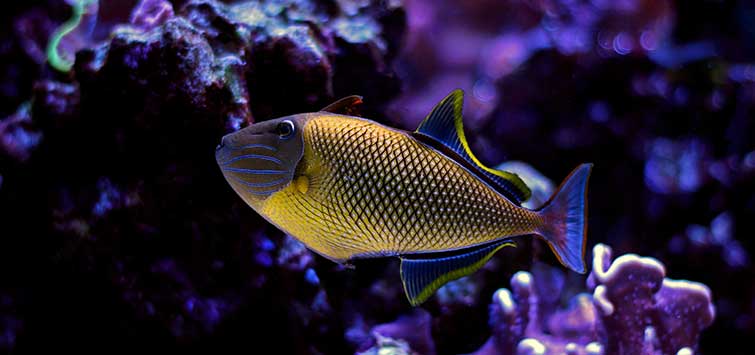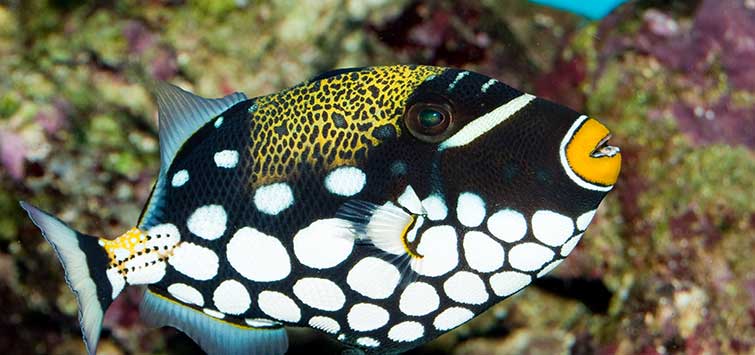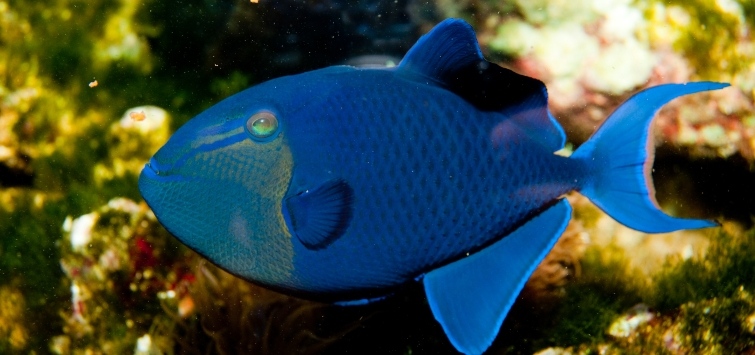Reef-Friendly Triggerfish
Author: Scott W. Michael
A world-renowned reef fishes authority examines a variety of triggerfish that are suitable additions to a reef aquarium and the dangers they might pose to invertebrates and corals.
“A triggerfish in a reef tank? Are you kidding me?”
That is how people often respond to the suggestion of adding one of those fish to their prized reef aquarium. While the majority of triggerfish are not suitable for most reefs, there is a small group of triggers that are exceptions to the normally held rule. In this article we will examine those triggerfish and look at the calculated risk of keeping some of the less suitable species with your invertebrates and corals.
Trigger Biology
The triggerfish belong to the family Balistidae, which comprises 11 genera and approximately 40 species. The common name for the family is derived from the second dorsal, or “trigger,” spine. When a triggerfish is threatened or resting, it will wedge itself into a hole and erect the first dorsal spine, which is then locked into place by the second dorsal spine. The only way to remove the fish when it is thus secured is by depressing the “trigger” spine, which causes the first dorsal to “unlock.” However, this is often a difficult task, and attempting to do so may inadvertently injure a triggerfish. Therefore the best way to transfer a triggerfish hiding in aquarium decor is to move the piece of rock or coral along with the fish.
Triggerfish are laterally compressed, have relatively small mouths equipped with chisel-like teeth, heavily muscled jaws, and eyes that are positioned far back on the head. The powerful jaws and teeth are used to crush hard-shelled prey items, while having the eyes far from the mouth ensures that these vulnerable organs will not be damaged by sharp-spined prey items like sea urchins.
Triggerfish swim by sculling with the soft anal and dorsal fins (this is known as the balistiform swimming mode), but if a sudden burst of speed is required they will use rapid sweeps of their tail. Triggerfish occur in all tropical oceans, and most species associate with rocky outcroppings or coral reefs. There are several species that lead a pelagic lifestyle, roaming about the open ocean or living among sargassum algae rafts. But most species inhabit relatively shallow coastal waters. Some triggerfish are sexually dimorphic and/or sexually dichromatic; for example, in many species males are larger than females.
Trigger Tankmates
In general, triggerfish are extremely durable aquarium inhabitants. They are among the most rugged of all aquarium fish, withstanding poor environmental conditions and rarely succumbing to disease. They also have voracious appetites and are not finicky eaters. Triggerfish can even be used to cycle a new tank, but, because they are often aggressive, using them that way may cause a problem if you hope to add any other fish to the aquarium. The biggest triggerfish shortcoming is their tendency to be rather bellicose. Although they vary somewhat in their disposition, most species should be kept on their own or in a species aquarium.
Genus Sufflamen and Rhinecanthus
The most aggressive triggerfish are the queen (Balistes vetula), gray (Balistes capriscus), blue-lined (Pseudobalistes fuscus), clown (Balistoides conspicillum), and the orange-lined triggerfish (Balistapus undulatus). Because those species are so pugnacious, it is usually a good idea to house them on their own or in very large tanks with other bullies. The members of the genus Sufflamen and Rhinecanthus can be kept with other fish as juveniles, but they tend to become more aggressive as they get larger. Adults should be kept on their own or with other large, contentious species.
Other Companions
Some fish often kept with triggerfish include moray eels (Muraenidae), squirrelfish (Holocentridae) , lionfish (Pterois) , groupers (Epinephelinae), snappers (Lutjanidae), large hawkfish (genus Paracirrhites), certain wrasses (such as hogfish, tuskfish, banana wrasses), large angelfish, surgeonfish, Arothron pufferfish, and porcupinefish. But even those fish may fall victim to the more aggressive members of the triggerfish family.
It is possible to keep vigilant small fish like damselfish and blennies in a tank with aggressive triggerfish if the aquarium is large enough and is packed with places for the smaller fish to hide. Although morays are commonly kept with triggerfish, their tails are particularly attractive targets for triggerfish to bite, so it is important that morays be provided with several large hiding places that will allow them to conceal themselves completely. You should not house triggerfish that feed on encrusting invertebrates with frogfish or scorpionfish that resemble reef substrate, as they are likely to nip at these species. Even though triggerfish have small jaws, their powerful jaw muscles and teeth can cause considerable tissue wounds when they decide to take a bite.
Heater Biting
Triggerfish have also been implicated in biting and damaging glass aquarium heaters and both flexible and rigid tubing. Although heater biting is a relatively rare event, it is a good idea to protect that piece of equipment by placing it in a sump. If your aquarium is “sumpless” you can build a barrier around your heater using egg crate material or a piece of plastic that has had numerous holes drilled in it (e.g., material commonly sold for tank dividers).
The best option, though, is to obtain a titanium heater, which is totally resistant to a triggerfish’s jaws. In addition to being trigger-proof, titanium heaters normally function better than standard glass heaters, and using an external thermostat reduces the risk of the heater’s getting stuck in the on position. Frequently check any airline tubing in the aquarium to see whether it needs to be replaced.
Triggerfish Behavior
Triggerfish quickly learn to solve simple problems. For example, it does not take long for most species to learn to recognize where the food comes from, and established specimens will “beg” at the water's surface every time their owner is in view. They will also spit water out of the aquarium.
Hydraulic Jetting
Triggerfish in the wild often engage in a behavior called hydraulic jetting. This action gets its name from a triggerfish’s directing a jet of water out of its mouth into the sand to uncover buried prey. Triggerfish also use hydraulic jetting to flip over protected prey items like spiny sea urchins.
In the aquarium they learn to associate the surface of the water, not the tank bottom, with food. So instead of spitting water at the substrate they blow it at the water's surface. Although interesting, this behavior can cause severe problems if your top is not totally covered and you have electrical outlets near the tank.
Feeding
One of the most important criteria for keeping healthy triggerfish is to feed them often–at least three and preferably five small meals a day. In order to maintain their color and health, they should be fed a varied diet, complete with fresh or frozen clams, urchins, freeze-dried seaweed sheets, frozen or steamed spinach leaf, and freeze-dried krill soaked in Selcon, or a comparable amino-acid.
It is important to feed triggerfish several times a day, as they will rapidly lose weight if fed sparingly. Although many aquarists like to hand-feed their triggerfish, you should be aware that triggerfish, especially larger specimens, can inflict painful injuries with their strong jaws and teeth. When first introduced to the aquarium some triggerfish species can be quite shy and may hide whenever you approach their tank. But it will not take long before they become bold aquarium inhabitants.
Invertebrates
So what about invertebrates? Is it really possible to keep triggers with animals they may perceive as prey? The answer is yes and no. It is very important that you choose your triggerfish species and invertebrate tankmates very carefully. Many triggerfish have highly varied diets that include many different types of invertebrates, as well as plant material and small fish.
Take a look at a dietary study on the commonly kept rectangular triggerfish (Rhinecanthus rectangulus). This study lists the following in R. rectangulus stomachs (in order of importance in the diet): amphipods, tunicates, filamentous algae, crabs, polychaete worms, shrimps, coralline algae, snails, sea urchins, isopods, bryozoans, tiny clams, and crab larvae! There are a lot of animals in that list that many reef aquarists would prefer to have flourish in their tanks. But note that there were no corals listed. That does not mean that all triggers are not a threat to corals.
Triggerfish are very opportunistic, and some larger species have been known to bite off coral branches to get at crabs or echinoderms that are hiding within a coral colony. Those species would indeed be unwelcome in your small-polyped stony coral tank. There are also food habit studies that have listed the tips of stony corals in trigger stomachs.
Genera Melichthys, Odonus, and Xanthichthys
The best triggerfish for the reef aquarium belong to the genera Melichthys, Odonus, and Xanthichthys. Of those three genera, the latter is the very best for the reef aquarium—this includes the bluechin (X. auromarginatus), the crosshatch (X. mento), and the sargassum triggerfish (X. ringens). The niger triggerfish (Odonus niger) is more likely to hunt down motile invertebrates and may occasionally eat sessile invertebrates like sponges.
The triggers in the genus Melichthys—including the Indian (M. indicus), black (M. niger), and pinktail triggerfish (M. vidua)¬—feed heavily on floating algae and thus usually behave well with sessile invertebrates. While those species usually do well with corals, they may occasionally decide to dispatch a crustacean here or there, especially if the latter are introduced after the trigger is already in the tank.
Reef Trigger Differences
The triggerfish that are better suited to the reef aquarium have some special qualities that make them more “invert-friendly.” First of all, most of the species that are good for reef aquariums feed primarily on zooplankton or floating algae. As a result, they are “designed” a little differently from their less selective cousins. They have slightly smaller mouths (not well suited for destroying aquarium equipment, including heater tubes!) that are a bit higher up on the head.
Behavior
As far as their behavior is concerned, they tend to spend more time in the water column hunting their Lilliputian foods. Some of them (e.g., the crosshatch triggerfish, Xanthichthys mento) form groups because they are more vulnerable when they are farther from the reef. They choose to feed together because there is safety in numbers.
Those triggerfish that feed heavily on benthic invertebrates have other unsuitable reef tank habits. When searching for prey, they will lift bits of rubble in their jaws and blow jets of water out of their mouth at the sand to uncover buried prey. They may even lie on their sides and paddle with the pectoral fin nearest the sea floor, producing holes in the sand. Moving sand is not necessarily a big deal–although they may bury corals placed on or near the aquarium bottom, or stir up debris within the aquarium, which can cause severe stress to LPS coral species.
The lifting and dropping of debris, rubble, and even small coral colonies can cause severe injury to coral polyps. By the way, these behaviors are fascinating to observe! If you want a fish that exhibits an amazing behavioral repertoire, you may consider dedicating a whole tank to one of these personable pets.
Pugnaciousness
One of the most appealing differences between the reef-safe triggers and their more dubious cousins is their level of pugnaciousness. The genera that do best in reef tanks tend to be the least aggressive members of the family. That said, even those species may “go bad” and try to eat a smaller fish that is added to a tank where they are established residents.
In most reef communities these triggers should be the last fish added to any community tank. The aquarist should be aware that with any triggerfish the problem of aggression is exaggerated if they are kept in smaller aquariums or under crowded conditions. I should point out that almost all triggerfish species (and most other fish) display some degree of individual variation.
A final note: of all the potential reef aquarium triggers, I have seen individual Indian triggerfish (M. indicus) behave badly more than any of the other potential balistid candidates. I have had individuals in large tanks (over 700 gallons [2646 liters]) that bullied, nipped, and even dispatched their tankmates (in some cases, piscine neighbors that were as long as they were).
Getting Adventurous
Some aquarists are more adventuresome than others and willingly take risks when it comes to mixing fish with their invertebrates.
For those of you who fall into that category, it is possible to keep some of the triggers that have a more varied diet in a reef tank with certain invertebrates. For example, I once saw a clown triggerfish (Balistoides conspicillum) in a reef tank! The owners said they had the trigger in the tank for over a year and that it had not caused any problems. The cnidarian community consisted mainly of soft coral “trees” (e.g., Sinularia, Litophyton, Lemnalia).
Many of those soft corals have toxins that make them unpalatable to the general predator. The tank contained no crustaceans, as the trigger would most likely make short work of them, but there were small demoiselles (Chrysiptera spp.) that would dart into tight hiding places when the triggerfish got too close!
The other thing that helped reduce the level of destruction wrought by the trigger was the feeding regimen–the triggerfish was fed chunks of seafood several times a day. Not only does frequent feeding mean your trigger is fat and happy, it also means the balistid is less likely to eat its neighbors.
Pulling the Trigger
In conclusion, if you are careful about the invertebrates you select for your reef tank, it is even possible to keep some potentially destructive triggers in your reef. For those who do not want to take as much of a risk, there are also a number of plankton-feeding balistids that are well better suited to the reef tank environs.
As with any fish, maintaining a healthy environment is key to keeping your triggers happy! Contact an aquarium cleaning service if you need help with water changes, gravel vacuuming, and other important duties.

.png?h=595&iar=0&w=2781&hash=5FD5E69473BCC22199FBFA2FB71B6033)

.png?h=250&iar=0&w=970&hash=CB4184B478B298E60EE37B6A8FADE4DE)

